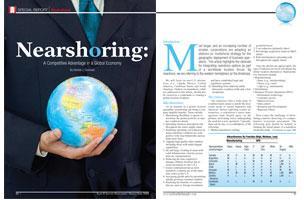
 Introduction
Introduction
Most larger, and an increasing number of smaller, corporations are adopting an allshore (or multishore) strategy for the geographic deployment of business operations. This article highlights the rationale for integrating nearshore options as part of a worldwide location thrust. By nearshore, we are referring to the western hemisphere (or the Americas).
We will focus on non-U.S. alternatives, (i.e., Canada, Mexico, Central America, Caribbean Basin, and South America). Onshore (or smartshore), while not addressed in this article, should also be viewed as a component to creating a global location footprint.
Why Nearshore?
As an element in a global location game plan, nearshoring can bring a company tangible benefits. These include:
1. Maximizing flexibility to upsize or downsize the global portfolio as market conditions dictate
2. Spreading business description risk throughout the entire supply chain
3. Realizing operating cost reduction as many nearshore countries are competitive with Asia behemoths such as India and China
4. Tapping high quality labor markets including those with multi-lingual capabilities
5. By and large, locating in areas with solid infrastructure (electric power, telecom, transportation)
6. Reducing the time required to manage offshore facilities due to closer proximity (to the U.S.)
7. Easier communications as most nearshore countries are in the same time zones as the U.S.
8. Increasing global sales by penetrating rapidly growing consumer markets
9. Realizing the benefits of countries that are open to foreign investment and have established legal and regulatory systems
10. Benefiting from relatively stable democratic countries (with only a few exceptions).
The Choices
The Americas offer a wide array of countries/metro areas to satisfy the locational needs of varied industries and functions. Before exploring country alternatives, a corporation’s senior management team should agree on the primary motivating forces undergirding the need for a new operation. Typically, these can be one, or a combination, of the following:
1. Market penetration (selling goods/services)
2. Cost reduction (primarily labor)
3. Knowledge acquisition (such as R&D talent)
4. Risk minimization (spreading risk throughout the supply chain).
Once the drivers are agreed upon, the type of function involved will dictate the initial location alternatives. Representative functions include:
Manufacturing
Basic (e.g., metalworking)
Heavy (e.g., steel)
Light (e.g., instruments)
Distribution
Business Process Operations (BPO)
Information technology
Customer service
Shared services
Data centers
Research and Development
Regional offices
Now comes the challenge of shortlisting countries deserving of a comprehensive locational assessment. The following grid should be helpful in framing the initial phase of a nearshore locational study.
|
| |||||||
|
|
|
| |||||
|
|
|
|
|
|
|
|
|
|
|
|
|
|
|
|
|
|
|
|
|
|
|
|
|
| |
|
|
|
|
|
|
|
|
|
|
|
|
|
|
|
|
|
|
|
|
|
|
|
|
|
|
|
|
|
|
|
|
|
|
|
|
|
|
|
|
|
|
|
|
|
|
|
|
|
|
|
|
|
|
|
|
|
|
|
|
|
|
|
Many countries in the Americas are highly cost competitive. This is especially true since the recent decline of the U.S. dollar (with a couple of exceptions such as Canada).
Given wage escalation in established China and India cities, many Americas countries are at least in the ballpark concerning operating costs with the two Asia stalwarts. Labor cost differentials have narrowed. Energy and occupancy costs, depending on location, are often similar. In addition, due to rising fuel prices, transportation costs (i.e., shipping to U.S.) are more advantageous in the Americas.
As labor generally comprises a predominant cost component, the following chart illustrates the attractiveness of many nearshore countries.
|
| ||
|
|
|
|
|
|
|
|
|
|
|
|
|
|
|
|
|
|
|
|
|
|
|
|
|
|
|
|
|
|
|
|
|
|
|
|
|
|
|
|
|
|
|
|
|
|
|
|
|
|
|
|
|
|
|
|
|
|
|
|
|
|
|
|
Notes:
* Recent college graduate with English speaking capabilities.
** Five years experience and bi-lingual not necessary.
Once several countries are in the mix, the challenge then becomes identifying metro areas that can satisfy human capital and other operating requirements. In smaller countries (such as Central America) the choices are usually limited to one or a couple of places due to infrastructure and size of labor pool. However, in larger nations, distinct choices are available. These include (a) well established centers of foreign direct investment, and (b) emerging centers that have the necessary resources, mainly labor and infrastructure, to accommodate new business operations.
Some operations need to be in established areas wherein business costs (especially labor) and competition for labor are higher. Examples would be manufacturers needing close proximity to major customers, distribution centers and selected R&D functions.
But many businesses have a high degree of geographic mobility. They can opt for locations that have less direct labor market competition and offer noticeably lower operating costs. For such businesses the “hunting in packs” syndrome, while maybe safe over the short-haul, could prove to be disadvantageous over the long-haul. Therefore, locationally active companies should at least consider relatively undiscovered locations within targeted countries. Examples of such metro areas by country include:
|
|
|
|
|
|
|
|
|
|
|
|
|
|
|
|
Additionally, Central American Countries have attracted manufacturing enterprises such as apparel, toys and electronics. But they also offer opportunities for small to mid-size BPOs (IT and customer service). These would include entities requiring a modest number of bi-lingual (Spanish/English) workers. Among these countries are:
El Salvador
Honduras
Panama
Dominican Republic
Cost Rica (more discovered than the others)
Location Factors
Offshore (including nearshore) location factors are similar to those that must be taken into account on domestic site selection searches. But there are several factors which must be accorded special attention. These include the following:
1. Marketplace
Size
Composition
Customer proximity
Unique characteristics
Growth
Tariffs
Trading blocs
Bi-lateral trade agreements
2. Labor Market
Supply(including bi-lingual if appropriate)
Competitive demand
Costs
Wages
Benefits (mandated and customary)
Stability
Absenteeism
Turnover
Quality
Education
Work ethic
Productivity
Legislation
Hiring
Firing
Work hours
Contract workers
Unionization
Unionized companies
Organizing regulations, including employer rights
Training resources
3. Transportation infrastructure
4. Electric power
Capacity
Reliability
Cost
5. Telecommunications
Providers
Broadband
Reliability
Cost
6. Risk
Natural disaster
Financial (especially currency stability)
Political
Corruption
7. Intellectual property protection
8. Restrictions on business and real estate ownership
9. Land/building costs
10. Typical lease terms/conditions
11. Business climate
Taxes on foreign owned business
Rules of incorporation
Profit repatriation
Possible incentives
12. Presence of SEZs
Special Economic Zones
Typically with solid infrastructure and maximum incentives
13. Time Zone
14. Security
Expatriates/visitors
Onsite
Internet
15. Business customs/cultural differences
Conclusions
As this article demonstrates, nearshore locational alternatives can comprise an integral component of a company’s global geographic deployment strategy. The diversity of countries in the western hemisphere can accommodate the locational requirements of most industries/functions. Concerning costs, many Americas countries are competitive with China and India.
When siting new facilities, it is prudent to examine emerging locational hotspots. The “lemming effect” can work against a company’s best interest over the long term. Whether locating in a well-established, or an up and coming area, companies are well advised to have an exit strategy. Due to vicissitudes of a global economy, there are no guarantees thata good location today will remain so in the future (e.g., dramatic change in currency relationships).
Finally, due diligence in nearshore site selection necessitates closer examination of several factors that might be accorded lesser status on domestic projects. Such factors include loaded wage rates, labor legislation, market characteristics, transportation/utility infrastructure, exchange rate trends, political/financial stability, security, foreign company taxation, tariff/trade agreements, special economic zones, and business customs/cultural proclivities.

